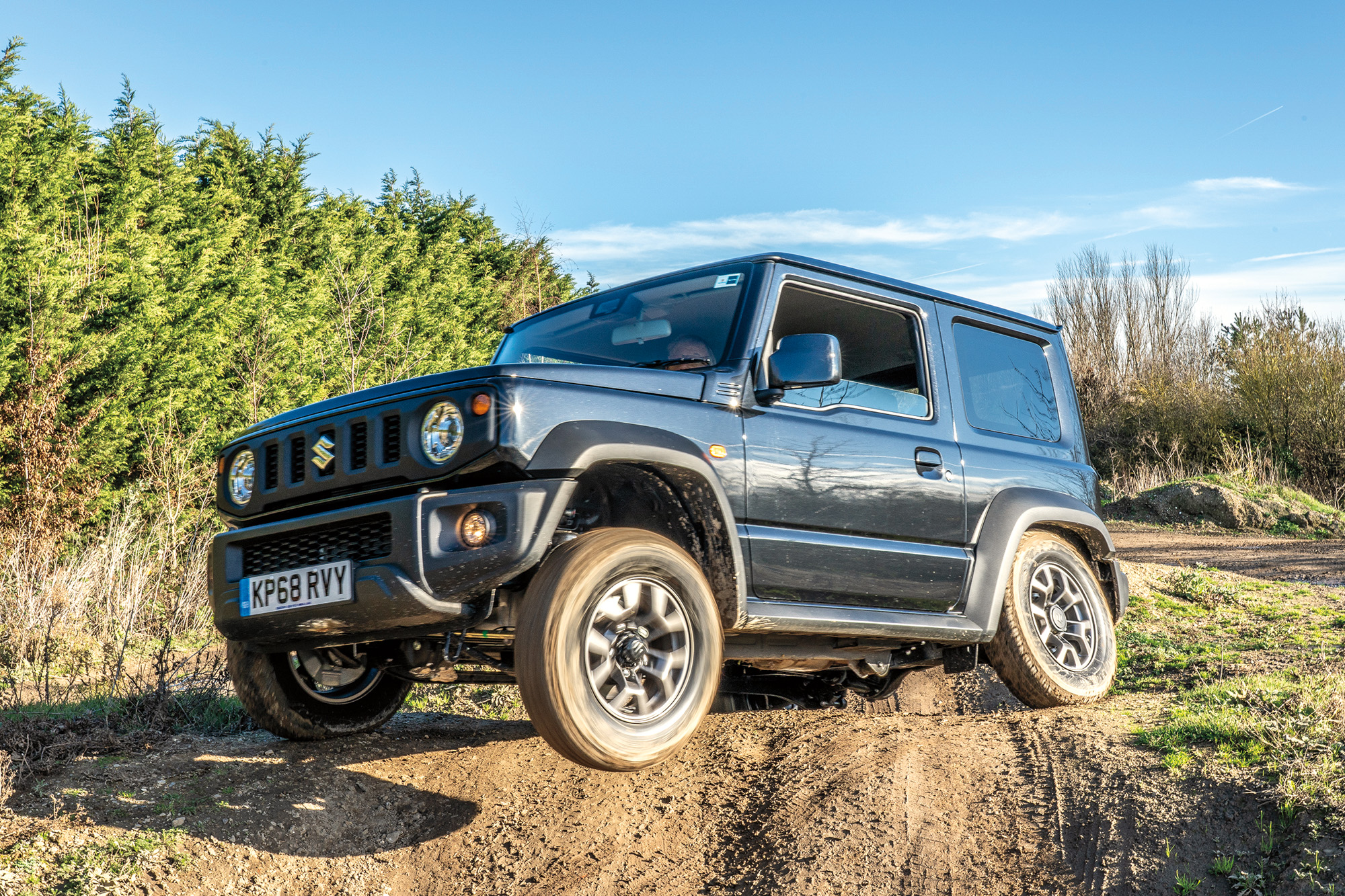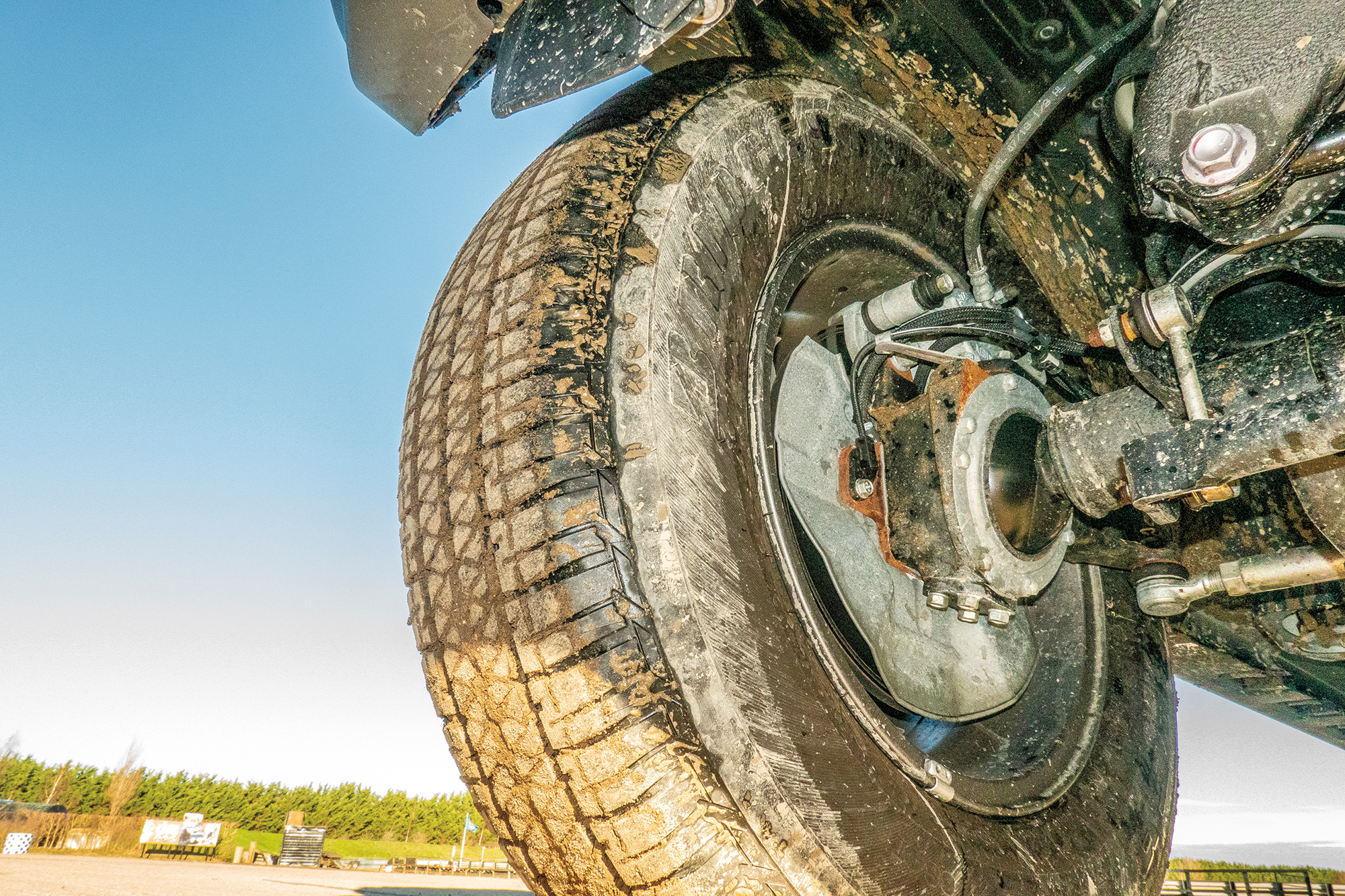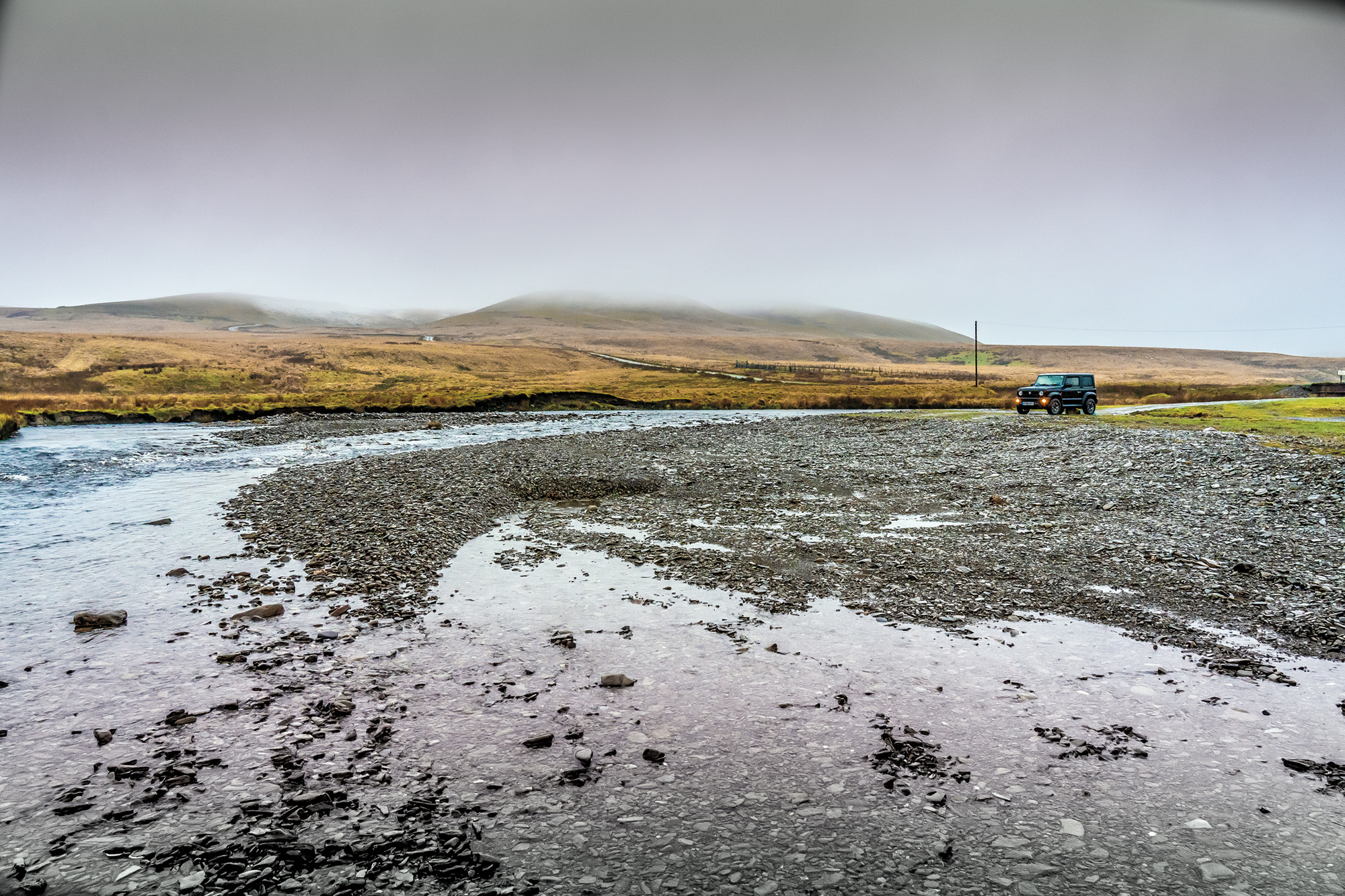This article was originally published in Overland Journal’s Gear 2020 issue.
If you find the absurdity of black leather seats scaldingly hot or sticky in summer and dark-slippery-cold in winter; if the advantage of flush, pop-out door handles escapes you; if a line of 10 tiny touchscreen icons has you taking off your gloves, reaching for your spectacles, scowling in irritation while trying not to run off the road at your second attempt to hit the right one and have it register your touch; if 500 watts of ear-splitting audio is not what you’re looking for; and if a gross weight nudging 2.5 tonnes is not your target—then Suzuki’s new Jimny will bring an overdue, contented smile to replace your mounting impatience with the baubles of auto fashion.
For such is the effect of Suzuki’s breath-of-fresh-air new 4×4. It is hard not to imagine that, in their quest for a return to reality, Suzuki’s designers didn’t high-five all round to gales of laughter when the pragmatism of their functional design philosophy begat a vehicle externally akin to a 461 G-Wagen in miniature (and 1,000 kilograms or 2,200 pounds lighter). And they weren’t that far off in terms of functionality either, albeit influenced by the need to keep the cost to sensible limits.
The cool breeze of simplicity hits you in your first hundred yards at the wheel. But Suzuki has been clever in avoiding the impression of penny-pinching frugality. Practicalities have been addressed, and the important boxes ticked—air conditioning, sat-nav, electric windows—mixed in with big door mirrors, and comfortable seats in breathable fabric that can be raised as well as slid. The rear seats fold flat and firm for a strong and practical cargo floor.
Unlike my Renegade that allows rain to drip through slightly open windows onto the electric window controls, Suzuki has not only positioned the window switches on the centre console but provided roof rain gutters, cheekily kicked-up at the back end just like a 461. And, also like a 461, the spare wheel is hung on the robustly hinged back door; a back door that, with rear light clusters tucked away in the bumper beneath, extends full-width to match the interior and allow the largest boxes to be slid onto the folded back seats.
And—the hint of a do-ist as well as a stylist being involved— the front passenger seat backrest folds back, not forward to hit the dash. The result is the ease of being able to sleep, full-length, in the vehicle or carry 6-foot timbers alongside the driver when errands so demand.
So how big is it then? Depending on whose dimensions summary you have turned up, the new Jimny is 233 millimeters (9.2 inches) shorter and 145 millimeters (5.7 inches) narrower than a two-door classic Land Rover Defender. It’s 625 millimeters (24.6 inches) shorter and 230 millimeters (9 inches) narrower than a 2-door Jeep Wrangler Sahara. Although, if they were good friends, you could squeeze three into the back row of a Wrangler or Defender, all three vehicles are basically comfortable four-seaters in normal passenger mode.
The underbelly ramp angle on the Jimny is 28 degrees against the 2-door, new Defender’s 31 degrees and the Wrangler Sahara’s approximate 25 degrees. Such angles are relevant to off-pavement capability but must also be viewed in the light of wheel and tyre sizes. The Jimny loses out a little on 15-inch wheels with (standard) 195/80R15 tyres, albeit its 210 millimeters (8.3 inches) under-diff ground clearance was only 5 millimeters less than the Defender on slightly oversized 7.50/C16 tyres. The Wrangler, on 17-inch wheels, beat it by a thumb-knuckle with 246 millimeters (9.69 inches) quoted.
If the dimensions don’t say enough, weight is an eyebrow-raiser. Gross weights (GVW) and max payloads in kilos respectively are 2,400/717 kilograms for the Defender 90; 2,286/433 kilograms for the less hard-work focused Wrangler Sahara. The Jimny is more than 1,000 kilograms (2,205 pounds) lighter than those two to yield a loaded gross weight of only 1,435 kilograms (3,164 pounds), of which 300 kilograms (660 pounds) is payload.
Swaggering copy in tearaway motoring journals misguidedly comment on the Jimny’s slight lean-on cornering and its supple suspension, not realising this is another of its strong points off pavement. An anti-roll bar (sway bar) is fitted but has been finely judged with the off-road/on-road balance in mind.
SO, WHAT’S IT LIKE?
With the UK allocation of Jimnys already sold out and not due for replenishment “until 2020” (yes, that vague), I was lucky to obtain a week’s loan of a press vehicle with a 4-speed Aisin automatic transmission and essentially normal, production-standard road tyres. And just enough time for the off-road course in the next county before heading west for some wild camping.
The Jimny has selectable 4×4, no centre differential, autolocking freewheel front hubs and, in effect (bearing in mind the manual and auto versions), a 2-speed transfer gearbox giving the standard 2H, 4H, and 4L drive options. Axle differentials are open but anti-wheelspin is scarcely identifiable in high range and amounts principally to some reduction in engine torque. The handbrake, mercifully, is a simple manual lever just like grandpa used. Power steering with constant-velocity, front-wheel drive-shaft joints is provided for smooth steering feel in 4×4 and gives the drive shafts an easier time.
The SZ4 base version Jimny has aircon, cruise control, ABS, and a CD tuner. The SZ5 adds same-size 15-inch alloy wheels, navigation, and DAB radio on a centre screen, heated front seats, and LED headlights with washers.
Tanks—yes, heavy, tracked military transport of the unstoppable kind—off road, seem to turn fore-and-aft pitching into an extravagant ballet. In the process, when going over humps, they plunge vigorously over the far side to thrust their multi-tonne heft downhill to dig a deeper dip than was there before. Such were the users of our target off-course before it became civilianised and provided owners the graded opportunity to see what their wagon could really do off pavement. The result gave enough climbs, dips, belly scratching, and wheel-spinning diagonal hump-crossing to exercise any self-respecting off-road 4×4 and its driveline.
Nimble, sprightly even, best describes the Jimny’s despatch of such terrain. Unlike the 461, and all other G-Wagens, the new Jimny, as mentioned above, does not come with axle diff locks to lock left and right drive shafts together. Instead, like close to 99 percent of other 4x4s, it has braked-wheel traction control in which excessive wheelspin of any single wheel is sensed by the wheel-speed sensors in the ABS brakes and compared to the overall speed of the vehicle. When this happens, some finely calibrated—i.e., not full-whack-thump—brake is applied automatically to the excessively eager wheel. See below how Bentley, (yes, Bentley) addresses this problem.
Time to restate some well-enough-known but seldom-faced facts. Braked-wheel traction control, utilising the hardware and software of an already installed ABS anti-skid brake system, is an inexpensive part substitute for cross-axle diff locks where the left and right drive shafts are actually locked together. Properly programmed and safeguarded, traction control systems can do a pretty effective job of quenching wheelspin, thus feeding torque to the wheel that has grip. Individual manufacturers approach traction control in different ways. (Some disgracefully “brochurize” their system features by actually calling them “diff locks” when they aren’t.)
As we’re on the subject, a lifted, free-spinning wheel suddenly hitting the ground can suffer shattering shock loads; enough to snap a drive shaft like a cold carrot—as many past Defender users might attest. A spin-off advantage (as you might say) of braked-wheel traction control is that it will, in many cases, ensure the wheel does not return to earth at a high rate of spin. (BMW/Bentley’s Bentayga, with large heavy wheels, big tyres, and a spectacularly quick spin arrest, addresses the problem in depth and has a torsional shock absorber at each wheel plus a throttle back-off to protect its drive shafts from such torture.)
Full axle-diff-lock-equipped drivelines, however, can also experience torsional torment (and serious handling problems akin to frozen steering) if left engaged during sharp turns on hard, grippy pavement; outer wheels have to travel farther than the inner wheels and can’t if the axle diff is locked up. Front wheels and rear wheels, too, travel different distances in sharp turns so the same “transmission windup” can affect non-difflock equipped vehicles if there is no centre differential to promote calm. (As mentioned, the Jimny has no centre diff.)
Such diff-lock drivelines are usually built to withstand occasional mishandling, like forgetting to disengage all diff locks (or going into 2H) on firm ground, but the frozen steering (very high or almost immovable steering) feedback cannot be avoided. Nevertheless, for serious, prolonged, and demanding off-pavement work, selectable axle and centre diff locks (and a thinking, sympathetic driver) are best. Yes, G-Wagen 461 et seq. The braked-wheel, traction-control, diff-lock substitute, termed TCS—traction control system on the Jimny—has, of course, first to experience some wheelspin before it can be quenched. In order that the speed difference between the front wheels does not initiate early single-wheel braking when, for instance, doing a sharp turn in a parking lot, many TCSs are programmed to not operate at very low speeds. They are set up to only function above certain engine rpm—as I found, with a duo of Jeep UK techies on hand to analyse the setup on the Renegade on the same course. A shame that the delicate offroad approach is sacrificed to the heavy footed among us.
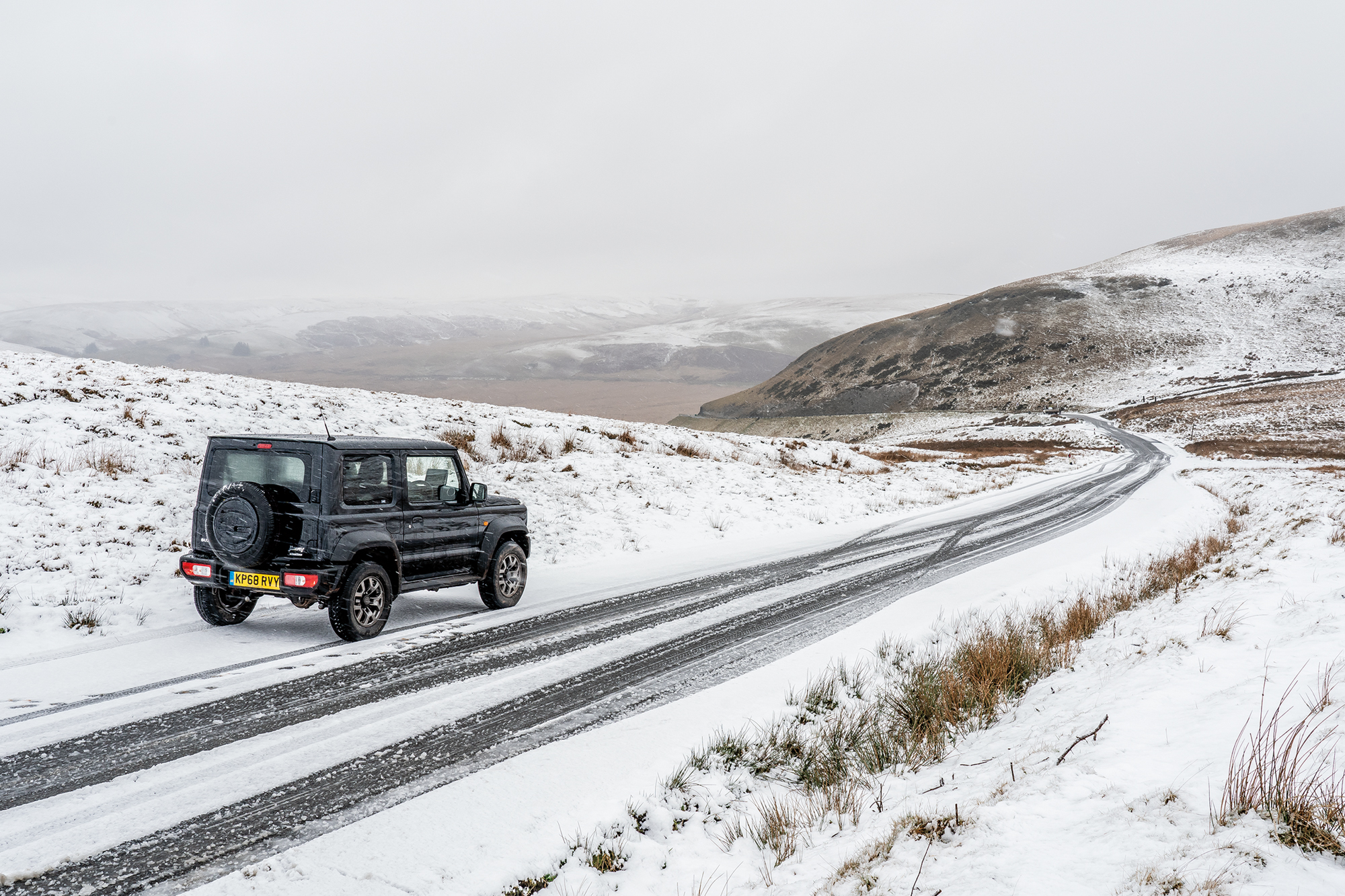
The Jimny braked-wheel traction control gurus, though, took a slightly different approach and designed separate triggering criteria for operation in high and low range. In high range, a slight reduction in engine torque takes place with minor wheel braking; neither aspect is noticeable but takes care of sharp 4H turns on hard pavement. In low range, however, sufficient wheel braking is apparent after a slight delay to slow the spinning wheel and restore useful torque to its companion on the other side of the axle. In practical terms, traction control works identifiably only in low range. Overall, the lightweight joyous agility of the Jimny was the lasting impression. (Joyous? Subjectively, yes.)
THE SMALLEST RV?
So far, proven at the off-road course on a sunny winter’s morn not far from home, it was now time to try some camping in wet-and-hilly Wales, off there to the west. Sunshine was exchanged for misty low clouds, some rather tentative snow, and a couple of cold but comfortable nights (sleeping full length in a sleeping bag) in the—yes, adequately roomy—Jimny.
Fuel first. Forty litres, the Jimny’s tank capacity, is only 10.6 US gallons. Not transcontinental but, with better than 37 mpg (Brit gallons) from the nicely responsive 1462cc petrol engine, not as worrying as it sounds. UK motorways have three lanes one way and three lanes the other. Two hundred miles of this at a leisurely 55-60 mph was no problem, comfort and ergonomics well addressed, and my still-amazing USB-fed Garmin Montana 600 logging everything you could possibly want to log.
My early notes say the poor little 4-speed Aisin automatic transmission (3-speed plus deselectable overdrive) desperately needs to be a 6-speed. The change from fourth down to third gear is accompanied by engine roar that’s hard to ignore. Admitting that my mechanical sympathy may be more finely tuned than that of many, I cringed a little every time I had to press harder on the throttle and forced a down-change. Nevertheless, it later dawned on me that, despite the mechanical upheaval going on, the gear change was still nicely smooth. If you turned the radio up loud enough you didn’t register it at all. Hmm, I still hope Aisin can produce a compact-enough 6-speed before too long.
For many moons, my El Dorado has had the ability to change easily from low to high range on the move. Why? If you’ve ever been in deep, soft sand you don’t have to ask—you need high range but dare not stop to engage it. Sure, with a lot of white-knuckle (the book says don’t) tap dancing on the pedals and multiple double-declutching it can be done (certainly, on the old Defender), but a simple transfer-lever-into-N-let-therevs- die and ease into high range is what you need. The G-Wagen, since time immemorial, has been able to achieve this. Land Rover woke to it in recent years. So no surprise that Suzuki, in a world used to being told to stop first, have gone along with stopping first. The additional cost and the requisite beefing up of the driveline to accommodate the folks who get it wrong will have been a factor.
THE CAMPING
My featherweight, minimalist camping regime is a long way from the ads in US off-road magazines. No awning, no heavyweight double-decker trailer, no fridge, no chairs or table, certainly no bonfire. What did I have? A three-legged canvas stool, a lithium-ion head torch, and a magnetic rechargeable LED inspection light stuck to whatever ferrous metal it could find on the side of the wagon. The hinged, propped lid of the food box served as a low-level table, a single-burner JetBoil, and for the dining room, a hook-on table/tray in the cab over the centre console to keep spilled soup or coffee out of the transmission lever recess and switches.
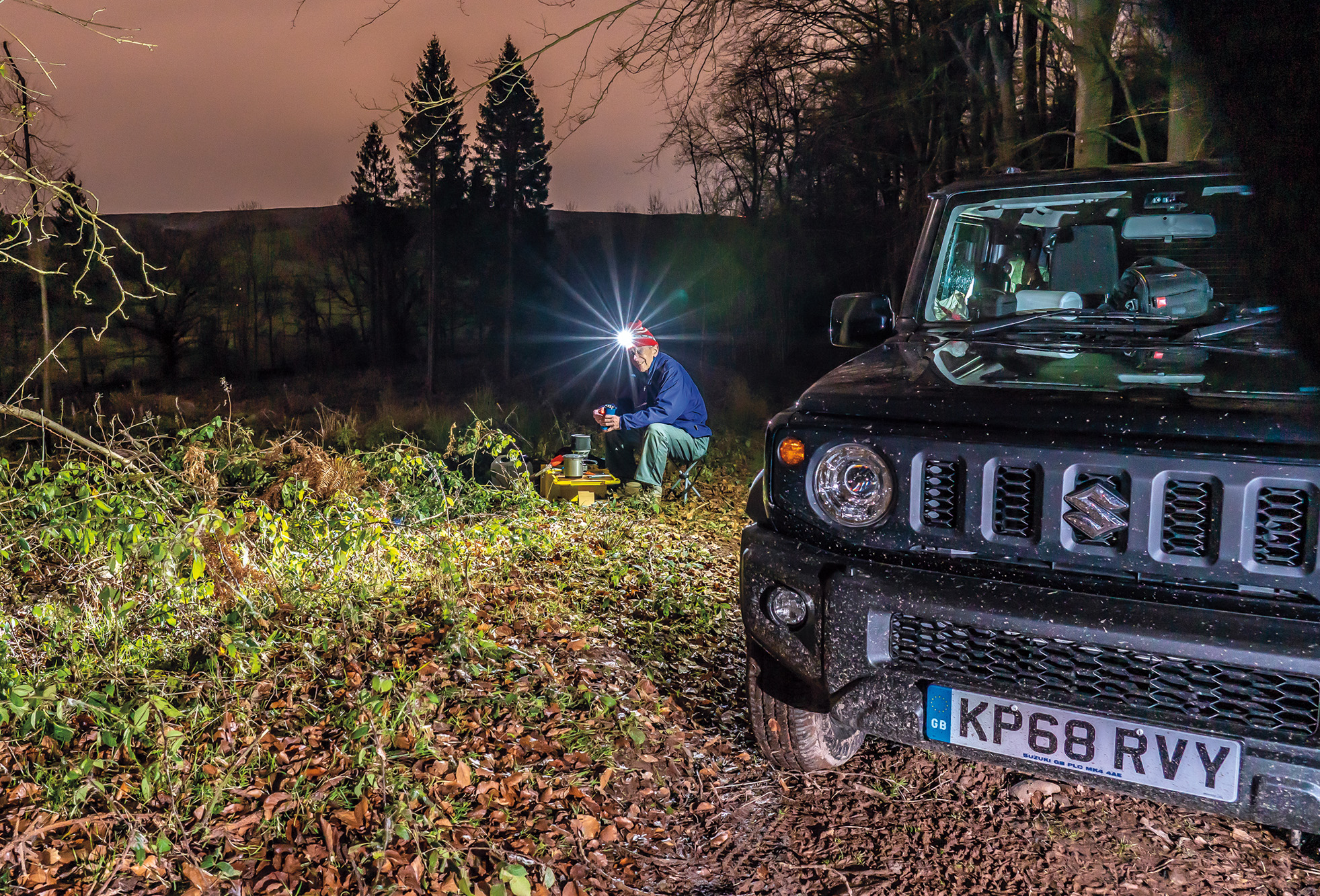
All do-able, efficient, and slick if you’re solo, as I usually am. Not yet a top-grade masochist, I’ve been known to start the engine and blower to warm the cab for a few minutes when I climb in with my soup, biscuits, and mug.
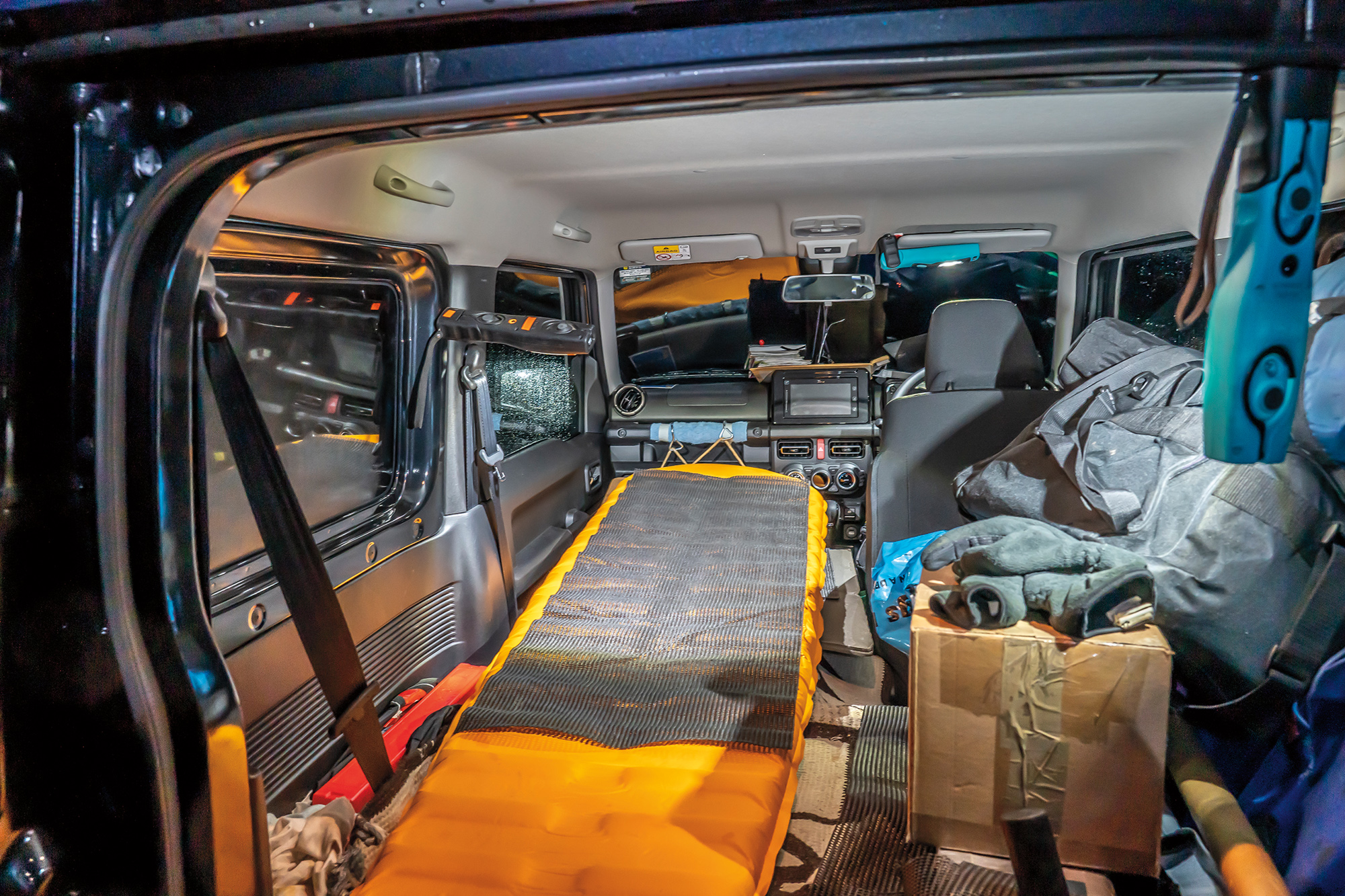
Sleeping in the Jimny was simple and absurdly comfortable. The clever bit is the Jimny’s backward folding passenger seat giving a pretty level platform progression to that perfectly flat back end, resulting from the folded rear seats. Not perfect enough for a comfortable night, though, and a single plywood board hooked onto the passenger grab handle (opposite, top left) gave a nicely sloping chaise longue over the back-folded passenger seat on which to put my Therm-a-Rest air mattress, anti-slip rubber mat, inflatable mini-pillow and sleeping bag. No flapping canvas in the night. Crack the left and right windows open an inch for a through-flow of fresh air, check the stars are shining out there and—comfy? Is the moon round? Let it rain, let it blow, let it snow—Zzz!


